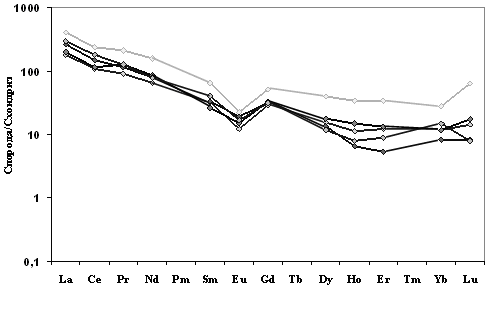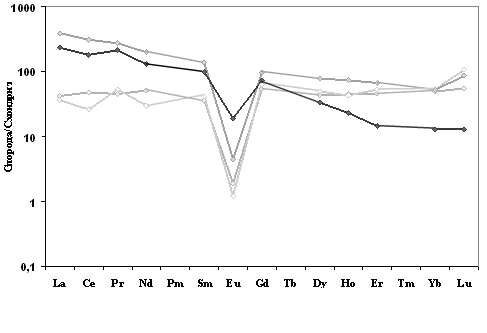|
KHANGAY GRANITOID BATHOLITH (MONGOLIA): GEOCHEMICAL FEATURES OF ROCKS AND CONDITIONS OF FORMATION
Grebenschikova V.I.*, Ochir G.**, Turutanov E.Kh.*** *Institute of Geochemistry SB RAS, Irkutsk, Russia, vgreb@igc.irk.ru **Mongolian University of Science and Technology, Ulan-Baatar, Mongolia ***Institute of the Earth’s Сrust SB RAS, Irkutsk, Russia, tur@crust.irk.ru
The massifs, composing the Khangay granitoid batholith, lie over the margins of the Khangay basin, and in its central parts they are somewhat outcropped on the surface. The total area of the batholith is over 120.000 km. The age is Permian. It mainly hosts diorites, quartz diorites, granodiorites and granites associated between each other by facies transitions. Leucocratic granites, in places alaskites are widespread. Formatioin of batholith was accompanied by rifting processes proceeding on its margins. The geophysical data indicate that at depths 2-15 km the Paleozoic granitoids of the Khangay batholith occupy much larger area than deduced from geological data. They produce the bodies occurring either on the boundaries between formations or within the faults. The composition of granite association of rocks is moderately alkaline, with a complete group of granites, which is indicated by the data on chemical and rare-element composition of granitoids. On the classification diagram (K2O+ Na2O) - SiO2 the rocks of the Khangay batholith produce one same trend of compositions. As regards the K2O/ SiO2 ratio, all rocks of batholith produce a compact distribution, corresponding to the same evolutionary trend, they are referred to the potassium calc-alkaline series. They can be differentiated rocks of the same magmatic chamber of gabbro or quartz-diorite composition. The dykes of leucogranites of the final stage do not produce their own trends, judging by the pattern of distribution of K2O, Al2O3, which is the case in the other batholiths, but they continue a general evolutionary trend of compositions of granitoids. The recalculation of chemical composition of granitoids of the Khangay batholith for mineral one, and plotting of norm data onto the diagram albite-anortite-orthoclase showed that all points of granite compositions occupy the fields of tonalities (diorites and quartz diorites), granodiorites and granites, gradually transformed one into the other. On the norm diagram the albite-quartz-orthoclase displacement of granodiorite composition points into the orthoclase angle is the evidence on initially cotectic granitoid melt and mesoabyssal level of its formation as sduggested by geophysical data. The compositions of batholith leucogranites are mostly approached to eutectic. The most vivid is a gradual transition of granitoid compositions from the deeper varieties (diorites) to the least deep ones (granodiorites and granites). The compositions of leucogranites continue the main trend of compositions of more deep-seated granitoids. From the contents of K, Rb, Ba, Sr and their ratios granodiorites of the Khangay batholith are approached to the composition of the upper continental crust, and gabbro and diorite inclusions correspond in compositions to the lower continental crust. The geochemical characteristics of batholith granodiorites comply with the parameters of plaingenic granitoids of normal alkalinity. Essential changes of lithophyle rare element contents, e.g. Rb, Cs, and Sr, Ва, in different facies of granitoids are correlated well with a silica content. The pattern of REE distribution is typically «granitic»: absence of Eu minimum in diorites, low Eu minimum in granodiorites, a deeper minimum in granites and maximum in leucogranites (Fig. 1). The main tendency in REE distribution consists in diminishing their sum in the later acid differentiated rocks and flattening of the distribution curve. The pattern of distribution of elements in granodiorites of the Khangay batholith and comparison with bulk composition of the continental crust showed that their compositions in general lie within the area of the upper-middle continental crust. The abundances of Nb, Ta, W, S are much lower. However, the concentrations in granites of K, Rb, Ba, Li and Zr and some other elements rank over their contents in the upper crust. The geological and geochemical parameters of the Khangay batholith exemplify formation of granodiorite model of palingenic granitoids. Formation of similar granitoid batholiths is due to the large-scale melting of the Earth’s crust affectd by mantle plume, which reached the lowermost crust, and subsequent crust anatexis (Yarmolyuk et al., 2002). Some other researchers consider formation of the Khangay batholith to result from the post-collision delamination and subsequent anatexis in the thickened crust (Gordienko et al., 2003).
The work is supported by the Integration project SB RAS № 6.17.
References Yarmolyuk V.V., Budnikov S.V., Kovalenko V.I. et al. Geochronology and geodynamic position of the Angara-Vitim batholith // Petrology. 1997. V. 5. № 5. P.451-466. Gordienko I. V., Kiseljov А. I., Lashkevich V. V. Delamination of lithosphere and associated magmatism in folded areas…/Problems of global geodynamics: Conf. Materials, 2000-2001./Ed. Rundquist D.V. – М.: ОГГГГН RAS, 2003. V. 2. P.185-198.
|


